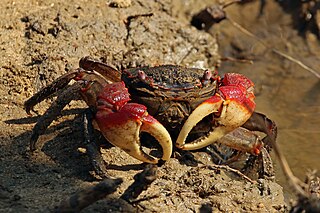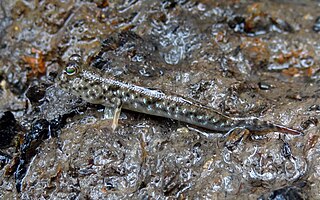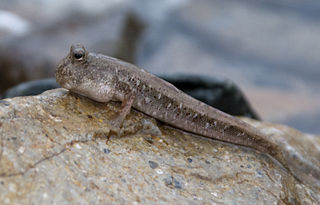
The Gellért Thermal Baths and Swimming Pool, also known simply as the Gellért Baths, is a bath complex in Budapest in Hungary. It is part of the famous Hotel Gellért in Buda.

Thermal pollution, sometimes called "thermal enrichment", is the degradation of water quality by any process that changes ambient water temperature. Thermal pollution is the rise or drop in the temperature of a natural body of water caused by human influence. Thermal pollution, unlike chemical pollution, results in a change in the physical properties of water. A common cause of thermal pollution is the use of water as a coolant by power plants and industrial manufacturers. Urban runoff—stormwater discharged to surface waters from rooftops, roads, and parking lots—and reservoirs can also be a source of thermal pollution. Thermal pollution can also be caused by the release of very cold water from the base of reservoirs into warmer rivers.

Erythema ab igneEAI, also known as hot water bottle rash, is a skin condition caused by long-term exposure to heat. Prolonged thermal radiation exposure to the skin can lead to the development of reticulated erythema, hyperpigmentation, scaling, and telangiectasias in the affected area. Some people may complain of mild itchiness and a burning sensation, but often, unless a change in pigmentation is seen, it can go unnoticed.

Amphibious fish are fish that are able to leave water for extended periods of time. About 11 distantly related genera of fish are considered amphibious. This suggests that many fish genera independently evolved amphibious traits, a process known as convergent evolution. These fish use a range of terrestrial locomotory modes, such as lateral undulation, tripod-like walking, and jumping. Many of these locomotory modes incorporate multiple combinations of pectoral-, pelvic-, and tail-fin movement.

Mudskippers are any of the 23 extant species of amphibious fish from the subfamily Oxudercinae of the goby family Oxudercidae. They are known for their unusual body shapes, preferences for semiaquatic habitats, limited terrestrial locomotion and jumping, and the ability to survive prolonged periods of time both in and out of water.

A walking fish, or ambulatory fish, is a fish that is able to travel over land for extended periods of time. Some other modes of non-standard fish locomotion include "walking" along the sea floor, for example, in handfish or frogfish.

The mangrove rivulus or mangrove killifish, Kryptolebias marmoratus, is a species of killifish in the family Rivulidae. It lives in brackish and marine waters along the coasts of Florida, through the Antilles, and along the eastern and northern Atlantic coasts of Mexico, Central America and South America. It has a very wide tolerance of both salinity and temperature, can survive for about two months on land, and mostly breeds by self-fertilization. It is typically found in areas with red mangrove and sometimes lives in burrows of Cardisoma guanhumi crabs.

The Gobiiformes are an order of fish that includes the gobies and their relatives. The order, which was previously considered a suborder of Perciformes, is made up of about 2,211 species that are divided between seven families. Phylogenetic relationships of the Gobiiformes have been elucidated using molecular data. Gobiiforms are primarily small species that live in marine water, but roughly 10% of these species inhabit fresh water. This order is composed chiefly of benthic or burrowing species; like many other benthic fishes, most gobiiforms do not have a gas bladder or any other means of controlling their buoyancy in water, so they must spend most of their time on or near the bottom. Gobiiformes means "goby-like".

Periophthalmus is a genus of fish in the family Oxudercidae, native to coastal mangrove wood and shrubland in the Indo-Pacific region, except for P. barbarus from the Atlantic coast of Africa. It is one of the genera commonly known as mudskippers. Periophthalmus fishes are remarkable for being able to live, temporarily, in open air where they feed with insects and small invertebrates; out of water they have limited motion abilities, such as jumping. All Periophthalmus species are aggressive and territorial.

The giant mudskipper is a species of mudskipper native to the tropical shores of the eastern Indian Ocean and the western Pacific Ocean where it occurs in marine, brackish and fresh waters. It is most frequently found along muddy shores in estuaries as well as in the tidal zones of rivers. It lives in a burrow in the mud and emerges from the burrow at low tide on sunny days. It can move quickly across a muddy surface and is capable of breathing both in and out of water. The giant mudskipper can grow to a length of 27 centimetres (11 in) TL. This species is of minor importance to local commercial fisheries. The specific name honours the Dutch physician and naturalist Johann Albert Schlosser (1733-1769), who was a friend of Peter Simon Pallas and who received the type from the East Indies and sent it to Pallas.

The Southern Africa mangroves are mangrove ecoregion on the Mozambique's southernmost coast and the eastern coast of South Africa.

The Atlantic mudskipper is a species of mudskipper native to fresh, marine, and brackish waters of the tropical Atlantic coasts of Africa, including most offshore islands, through the Indian Ocean and into the western Pacific Ocean to Guam. The Greek scientific name Periophthalmus barbarus is named after the eyes that provide the Atlantic mudskipper with a wide field of vision. The Atlantic mudskipper is a member of the genus Periophthalmus, which includes oxudercine gobies that have one row of canine-like teeth.

The shuttles hoppfish or shuttles mudskipper is a species of mudskippers native to fresh, marine and brackish waters of the northwestern Pacific Ocean from Vietnam to Korea and Japan. This species occurs in muddy estuaries, tidal flats and swamps and marshes and is capable of remaining out of the water for up to 60 hours so long as it is kept moist. This species can reach a length of 10 centimetres (3.9 in) TL. This species can also be found in the aquarium trade and is also used in traditional Chinese medicine.

The barred mudskipper or silverlined mudskipper, is a species of mudskippers native to marine, fresh and brackish waters from the African coast of the Indian Ocean, to the Marianas and Samoa in the western Pacific Ocean, and from the Ryukyus south to Australia. This species occurs in mangrove forests and nipa palm stands and can cross surfaces of mud while out of the water. This species can reach a length of 19 centimetres (7.5 in) TL. It can also be found in the aquarium trade.
Parasites of the barred mudskipper include Acanthocephalan larvae and the small Opecoelid Digenean parasite in the intestine and described from fish collected in New Caledonia.

The slender mudskipper is a species of mudskippers native to marine and brackish waters of the eastern Indian Ocean and the western Pacific Ocean where it is an inhabitant of the intertidal zone, capable of spending time out of water. This species can reach a length of 4.5 centimetres (1.8 in) SL.

The New Guinea mudskipper is a species of mudskippers native to fresh and brackish waters along the coasts of Australia and Indonesia. This species occurs in estuaries and tidal creeks as well as mangrove forests and nipa palm stands This species can reach a length of 8 centimetres (3.1 in) SL.

Pearse's mudskipper or Indian dwarf mudskipper, is a species of mudskippers native to marine and brackish waters along the coasts of the Bay of Bengal. This species is amphibious, dwelling in intertidal areas. It can reach a length of 10 centimetres (3.9 in) SL.
Platygobiopsis is a genus of gobies native to the western Pacific Ocean.
Darwin's mudskipper is a relatively newly discovered mudskipper in 2004, so little is known about it. It is a brackish water ray-finned fish found in Australia along mud banks never far from mangrove trees. It is in the goby family Gobiidae. It is named after Charles Darwin because the holotype was collected in Darwin Harbour. Its greatest distinguishing characteristic from other mudskippers is its greatly reduced first dorsal fin in both sexes.

Oxudercidae is a family of gobies which consists of four subfamilies which were formerly classified under the family Gobiidae. The family is sometimes called the Gobionellidae, but Oxudercidae has priority. The species in this family have a cosmopolitan distribution in temperate and tropical areas and are found in marine and freshwater environments, typically in inshore, euryhaline areas with silt and sand substrates.
















